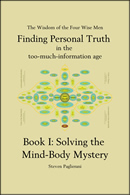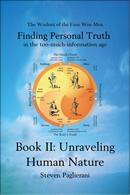Pattern 1 Life Events: Getting Overwhelmed
(we get lost in an unmade decision, during an ordinary life event)

What you see in this drawing is the first of the four life event diagrams in this series on "basic life events." In this case, what the diagram represents is the visual intensity of the most common life events in which people go into shock, those in which they get overwhelmed by a life decision.
What kinds of events do this to people? Any events in which people must [1] give up something you like in order to get something else they want and at the same time [2] feel pressured to decide within a certain amount of time. Examples of this situation would be if you were offered a new job for more money but had decide in two days and it involved moving, or if your girlfriend told you she loved you and wanted to marry you but she was tired of waiting and gave you a week to decide to do it or she was leaving.
What happens to people in these situations?
First, they get trapped by the"triage" element present, and by "triage," I mean, they get trapped by the idea that something must die so that something can live. So while the phrase 'triage" is most often used in medical settings wherein a doctor or nurse must decide who gets care first, the original meaning came from battlefield situations wherein the decision to work on one injured soldier often meant the others would die. Implicit in these decisions, then, was this idea, that the decision literally involved a life and death situation wherein helping one soldier meant others might die.
Certainly, we are not ordinarily involved in such painful situations. Still, the pain of ordinary life situations wherein you really feel pressured by time to decide between something you really want to keep and something new you really want to get can overwhelm people so much, they can go into shock. Herein lies the essence of this first kind of shocking life event, being overwhelmed by an ordinary life decision.
What is important to remember here is, while people are in shock, they do not lose but rather lose access to many of their normal life skills. Thus, even people with high degrees of life skills will temporarily lose access to these good skills. This means even those who are used to making decisions under pressure will, if temporarily overwhelmed, be at a loss and may even feel paralyzed while in these situation, only coming out when they make a decision.
As for the actual diagram, the important elements are the red dashed line, representing how intensely the person is internally picturing, and the large green area, which represents the degree to which the person has gone into shock.
Notice how, as the event progresses, the degree to which the person pictures the decision gradually increases until, at one point, the person goes into shock. This literally means the person ceases to be able to picture the choices. Eventually, though, the person makes decision and it is at this point, the person comes out of shock. The moment of this decision is what is represented by the small round yellow ball near the top of the red line, after which the person can picture not only clearly but at a very high level of consciousness. This internal clarity is why making decisions feels so good. Not only do they take us out of shock, they also send us into the realm of high consciousness.
Please note, this experience holds true even if the person's decision was simply to postpone or avoid the decision. Thus making a decision to not make a decision can feel just as good as making a good decision at times.




.png)